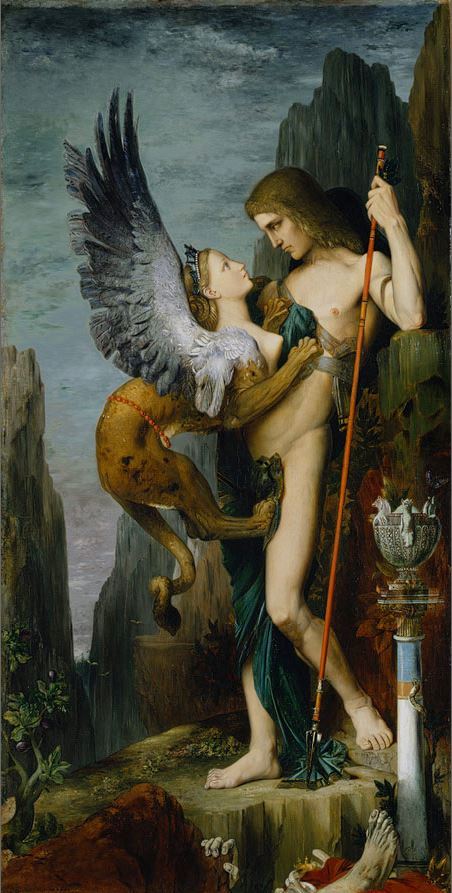
Gustave Moreau is recognised as a founder of the Symbolist movement in France, although his paintings in this style began being exhibited some 15 years before the movement is considered to have commenced. His favourite subjects were ancient civilisations and mythological themes which he portrayed in densely worked, encrusted canvasses.
He was chiefly influenced by Romantic painters Eugene Delacroix and Theodore Chasseriau and their use of exotic romanticism, dramatic lighting and bright colours. After Chasseriau’s untimely death at the age of 37, Moreau undertook a two year study trip to Italy from 1857, where he studied Renaissance masters and became convinced of the spiritual value of art. His travel through the towns and cities of Italy also exposed him to the influence of Byzantine enamels, early mosaics, and Persian and Indian miniatures, all of which played a significant role in the evolution of his individual style and in the jewel-like effect of his technique, noted Bennett Schiff in the Smithsonian in August 1999.
Like many other artists in Paris at the time, Moreau was also influenced by Asian art. In 1869, he attended the Palais de l’Industrie which was the largest and most extensive exhibition of Asian art held in Europe. It consisted of over 1,000 objects from China, Japan, India and Persia. Moreau sketched many of the works which were exhibited and incorporated the style of drawing into many of his works.
At the Paris Salon of 1864 Moreau exhibited his first major work, Oedipus and the Sphinx, which launched him into prominence. It established his lasting preoccupations with the opposition between good and evil, male and female and physicality and spirituality. To Moreau, the work represented humankind facing the eternal mystery of life with moral strength and self-confidence.
Schiff wrote that “Outstanding examples of psychological and physical detachment can be seen in one after another of Moreau’s paintings… In Oedipus and the Sphinx (1864), for instance, the winged creature – half nude female, half lion, an incubus clawed into Oedipus’ breast – does not seem to inflict pain at all. Instead, the grotesque creature and its placid victim appear to be dreamily engrossed in each other, although Oedipus is soon to answer the Sphinx’s riddle and she, or it, is to fall dead to the ground, finally, having already shredded any number of hapless voyagers unable to answer the riddle. Their bits and pieces are, in Moreau’s superbly rendered canvas, strewn about the foreground.”
In 1876 Moreau exhibited three of his most famous paintings in the Salon: Hercules and the Lernaean Hydra, Salome Dancing Before Herod, and The Apparition.
The Apparition portrays Salome who, according to the Gospels, bewitched the ruler Herod Antipas, the husband of her mother Herodiad, with her dancing. As a reward she was given the head of John the Baptist.
Several influences can be seen in this composition, including his copies of Japanese prints from the Palais de l’Industrie.
There is also a reference to head of Medusa, brandished by Perseus, in Benvenuto Cellini’s bronze in Florence (Loggia dei Lanzi). The decoration of Herod’s palace is directly inspired by the Alhambra in Granada. Through these various elements, Moreau recreates a magnificent, idealised Orient, using complex technical means such as highlighting, grattage* and incisions.
After the death of a close female friend in 1890 Moreau’s style altered. “His brushwork became looser and more expressive; his pigment grew thicker, more impastoed; and his forms became increasingly abstract,” Schiff wrote. “The overriding effect of these later paintings was to evoke an emotional response through the use of color, line and form. Some even view his later nonfigurative works as heralds of Abstract Expressionism. Certainly his art inspired a generation of Symbolist painters, poets and writers and had a marked impact on other artists.”
In 1888, Moreau was elected to the Academie des Beaux-Arts and at the age 65 he became a professor. He was considered by many as the last great teacher there. His influence on younger painters such as Henri Matisse, Albert Marquet and Georges Rouault extended to many art movements (Symbolism, Abstract Expressionism and Fauvism for example).
“He didn’t set his pupils on the right road,” Matisse said. “He took them off it. He made them uneasy…. He didn’t show us how to paint; he roused our imagination.” quoted Hilary Spurling in The Unknown Matisse: A Life of Henri Matisse: The Early Years, 1869-1908.
*Grattage is a technique in which (usually wet) paint is scraped off the canvas.
This blog is just a short excerpt from my art history e-course, Introduction to Modern European Art which is designed for adult learners and students of art history.
This interactive program covers the period from Romanticism right through to Abstract Art, with sections on the Bauhaus and School of Paris, key Paris exhibitions, both favourite and less well known artists and their work, and information about colour theory and key art terms. Lots of interesting stories, videos and opportunities to undertake exercises throughout the program.
If you’d like to see some of the Australian artwork you’ll find in my gallery, scroll down to the bottom of the page. You’ll also find many French works on paper and beautiful fashion plates from the early 1900s by visiting the gallery.







